Investigations of Optical Functions and Optical Transitions of 2D Semiconductors by Spectroscopic Ellipsometry and DFT
Abstract
1. Introduction
2. Theory and Methods
2.1. General Strategy to Investigate Optical Functions and Optical Transitions of 2D Semiconductors
2.2. Monolayer WS2 Examinations: A Typical Example
3. Results and Discussion
4. Conclusions
Author Contributions
Funding
Data Availability Statement
Acknowledgments
Conflicts of Interest
References
- Manzeli, S.; Ovchinnikov, D.; Pasquier, D.; Yazyev, O.V.; Kis, A. 2D transition metal dichalcogenides. Nat. Rev. Mater. 2017, 2, 17033. [Google Scholar] [CrossRef]
- Liu, H.; Neal, A.T.; Zhu, Z.; Luo, Z.; Xu, X.; Tomanek, D.; Ye, P.E. Phosphorene: An unexplored 2D semiconductor with a high hole mobility. ACS Nano 2014, 8, 4033–4041. [Google Scholar] [CrossRef] [PubMed]
- Blancon, J.C.; Even, J.; Stoumpos, C.C.; Kanatzidis, M.G.; Mohite, A.D. Semiconductor physics of organic–inorganic 2D halide perovskites. Nat. Nanotechnol. 2020, 15, 969–985. [Google Scholar] [CrossRef] [PubMed]
- Song, B.; Gu, H.; Fang, M.; Chen, X.; Jiang, H.; Wang, R.; Zhai, T.; Ho, Y.; Liu, S. Layer-dependent dielectric function of wafer-scale 2D MoS2. Adv. Opt. Mater. 2019, 7, 1801250. [Google Scholar] [CrossRef]
- Park, H.G.; Kim, T.J.; Kim, H.S.; Yoo, C.H.; Barange, N.S.; Le, V.L.; Kim, H.U.; Senthilkumar, V.; Le, C.T.; Kim, Y.S.; et al. Temperature dependence of the critical points of monolayer MoS2 by ellipsometry. Appl. Spectrosc. Rev. 2016, 51, 621–635. [Google Scholar] [CrossRef]
- Nguyen, H.T.; Kim, T.J.; Park, H.G.; Le, V.L.; Nguyen, X.A.; Koo, D.; Lee, C.H.; Cuong, D.D.; Hong, S.C.; Kim, Y.D. Temperature dependence of optical properties of monolayer WS2 by spectroscopic ellipsometry. Appl. Surf. Sci. 2020, 511, 145503. [Google Scholar] [CrossRef]
- Wei, M.; Lian, J.; Zhang, Y.; Wang, C.; Wang, Y.; Xu, Z. Layer-dependent optical and dielectric properties of centimeter-scale PdSe2 films grown by chemical vapor deposition. NPJ 2D Mater. Appl. 2022, 6, 1. [Google Scholar] [CrossRef]
- Ermolaev, G.A.; Grudinin, D.V.; Stebunov, Y.V.; Voronin, K.V.; Kravets, V.G.; Duan, J.; Mazitov, A.B.; Tselikov, G.I.; Bylinkin, A.; Yakubovsky, D.I.; et al. Giant optical anisotropy in transition metal dichalcogenides for next-generation photonics. Nat. Commun. 2021, 12, 854. [Google Scholar] [CrossRef]
- Guo, Z.; Gu, H.; Fang, M.; Song, B.; Wang, W.; Chen, X.; Zhang, C.; Jiang, H.; Wang, L.; Liu, S. Complete dielectric tensor and giant optical anisotropy in quasi-one-dimensional ZrTe5. ACS Mater. Lett. 2021, 3, 525–534. [Google Scholar] [CrossRef]
- Liu, Y.; Zeng, C.; Zhong, J.; Ding, J.; Wang, Z.M.; Liu, Z. Spintronics in two-dimensional materials. Nano-Micro Lett. 2020, 12, 93. [Google Scholar] [CrossRef]
- Schaibley, J.R.; Yu, H.; Clark, G.; Rivera, P.; Ross, J.S.; Seyler, K.L.; Yao, W.; Xu, X. Valleytronics in 2D materials. Nat. Rev. Mater. 2016, 1, 16055. [Google Scholar] [CrossRef]
- Mak, K.F.; Shan, J. Photonics and optoelectronics of 2D semiconductor transition metal dichalcogenides. Nat. Photonics 2016, 10, 216–226. [Google Scholar] [CrossRef]
- Liu, Y.; Duan, X.; Shin, H.J.; Park, S.; Huang, Y.; Duan, X. Promises and prospects of two-dimensional transistors. Nature 2021, 591, 43–53. [Google Scholar] [CrossRef] [PubMed]
- Das, S.; Sebastian, A.; Pop, E.; McClellan, C.J.; Franklin, A.D.; Grasser, T.; Knobloch, T.; Illarionov, Y.; Penumatcha, A.V.; Appenzeller, J.; et al. Transistors based on two-dimensional materials for future integrated circuits. Nat. Electron. 2021, 4, 786–799. [Google Scholar] [CrossRef]
- Chen, P.; Atallah, T.L.; Lin, Z.; Wang, P.; Lee, S.J.; Xu, J.; Huang, Z.; Duan, X.; Ping, Y.; Huang, Y.; et al. Approaching the intrinsic exciton physics limit in two-dimensional semiconductor diodes. Nature 2021, 599, 404–410. [Google Scholar] [CrossRef]
- Das, S.; Pandey, D.; Thomas, J.; Roy, T. The Role of graphene and other 2D materials in solar photovoltaics. Adv. Mater. 2019, 31, 1802722. [Google Scholar] [CrossRef]
- Cheng, Z.; Cao, R.; Wei, K.; Yao, Y.; Liu, X.; Kang, J.; Dong, J.; Shi, Z.; Zhang, H.; Zhang, X. 2D materials enabled next-generation integrated optoelectronics: From fabrication to applications. Adv. Sci. 2021, 8, 2003834. [Google Scholar] [CrossRef]
- Nayeri, M.; Moradinasab, M.; Fathipour, M. The transport and optical sensing properties of MoS2, MoSe2, WS2 and WSe2 semiconducting transition metal dichalcogenides. Semicond. Sci. Technol. 2018, 33, 025002. [Google Scholar] [CrossRef]
- Wang, J.; Xu, X.; Cheng, T.; Gu, L.; Qiao, R.; Liang, Z.; Ding, D.; Hong, H.; Zheng, P.; Zhang, Z.; et al. Dual-coupling-guided epitaxial growth of wafer-scale single-crystal WS2 monolayer on vicinal a-plane sapphire. Nat. Nanotechnol. 2022, 17, 33–38. [Google Scholar] [CrossRef]
- Li, M.Y.; Su, S.K.; Wong, H.S.P.; Li, L.J. How 2D semiconductors could extend Moore’s law. Nature 2019, 567, 169–170. [Google Scholar] [CrossRef]
- Zheng, L.; Wang, X.; Jiang, H.; Xu, M.; Huang, W.; Liu, Z. Recent progress of flexible electronics by 2D transition metal dichalcogenides. Nano Res. 2022, 15, 2413–2432. [Google Scholar] [CrossRef]
- Huang, L.; Krasnok, A.; Alu, A.; Yu, Y.; Neshev, D.; Miroshnichenko, A.E. Enhanced light–matter interaction in two-dimensional transition metal dichalcogenides. Rep. Prog. Phys. 2022, 85, 046401. [Google Scholar] [CrossRef] [PubMed]
- Kumar, P.; Lynch, J.; Song, B.; Ling, H.; Barrera, F.; Kisslinger, K.; Zhang, H.; Anantharaman, S.B.; Digani, J.; Zhu, H.; et al. Light–matter coupling in large-area van der Waals superlattices. Nat. Nanotechnol. 2022, 17, 182–189. [Google Scholar] [CrossRef] [PubMed]
- Bernardi, M.; Ataca, C.; Palummo, M.; Grossman, J.C. Optical and electronic properties of two-dimensional layered materials. Nanophotonics 2017, 6, 479–493. [Google Scholar] [CrossRef]
- Xie, K.; Li, X.; Cao, T. Theory and Ab Initio Calculation of Optically Excited States-Recent Advances in 2D Materials. Adv. Mater. 2021, 33, 1904306. [Google Scholar] [CrossRef]
- Thygesen, K.S. Calculating excitons, plasmons, and quasiparticles in 2D materials and van der Waals heterostructures. 2D Mater. 2017, 4, 022004. [Google Scholar] [CrossRef]
- Cudazzo, P.; Sponza, L.; Giorgetti, C.; Reining, L.; Sottile, F.; Gatti, M. Exciton Band Structure in Two-Dimensional Materials. Phys. Rev. Lett. 2016, 116, 066803. [Google Scholar] [CrossRef]
- Naik, M.H.; Jain, M. Origin of layer dependence in band structures of two-dimensional materials. Phys. Rev. B 2017, 95, 165125. [Google Scholar] [CrossRef]
- Molina-Sánchez, A.; Sangalli, D.; Hummer, K.; Marini, A.; Wirtz, L. Effect of spin-orbit interaction on the optical spectra of single-layer, double-layer, and bulk MoS2. Phys. Rev. B 2013, 88, 045412. [Google Scholar] [CrossRef]
- Zhao, W.; Ribeiro, R.; Toh, M.; Carvalho, A.; Kloc, C.; Neto, A.C.; Eda, G. Origin of indirect optical transitions in few-layer MoS2, WS2, and WSe2. Nano Lett. 2013, 13, 5627–5634. [Google Scholar] [CrossRef]
- Yoo, S.; Park, Q.H. Spectroscopic ellipsometry for low-dimensional materials and heterostructures. Nanophotonics 2022, 11, 2811–2825. [Google Scholar] [CrossRef]
- Alonso, M.I.; Garriga, M. Optical Properties of Semiconductors. In Spectroscopic Ellipsometry for Photovoltaics; Fujiwara, H., Collins, R.W., Eds.; Springer: Cham, Switzerland, 2018; pp. 89–113. [Google Scholar]
- Fang, H.; Bechtel, H.A.; Plis, E.; Martind, M.C.; Krishna, S.; Yablonovitch, E.; Javey, A. Quantum of optical absorption in two-dimensional semiconductors. Proc. Natl. Acad. Sci. USA 2013, 110, 11688–11691. [Google Scholar] [CrossRef] [PubMed]
- Lien, D.H.; Kang, J.S.; Amani, M.; Chen, K.; Tosun, M.; Wang, H.P.; Roy, T.; Eggleston, M.S.; Wu, M.C.; Dubey, M.; et al. Engineering light outcoupling in 2D materials. Nano Lett. 2015, 15, 1356–1361. [Google Scholar] [CrossRef]
- Sun, Z.; Martinez, A.; Wang, F. Optical modulators with 2D layered materials. Nat. Photonics 2016, 10, 227–238. [Google Scholar] [CrossRef]
- Chaves, A.; Azadani, J.G.; Alsalman, H.; da Costa, D.R.; Frisenda, R.; Chaves, A.J.; Song, S.H.; Kim, Y.D.; He, D.; Zhou, J.; et al. Bandgap engineering of two-dimensional semiconductor materials. NPJ 2D Mater. Appl. 2020, 4, 29. [Google Scholar] [CrossRef]
- Wilson, N.R.; Nguyen, P.V.; Seyler, K.; Rivera, P.; Marsden, A.J.; Laker, Z.P.L.; Constantinescu, G.C.; Kandyba, V.; Barinov, A.; Hine, N.D.M.; et al. Determination of band offsets, hybridization, and exciton binding in 2D semiconductor heterostructures. Sci. Adv. 2017, 3, e1601832. [Google Scholar] [CrossRef] [PubMed]
- Zhang, C.; Johnson, A.; Hsu, C.L.; Li, L.J.; Shih, C.K. Direct imaging of band profile in single layer MoS2 on graphite: Quasiparticle energy gap, metallic edge states, and edge band bending. Nano Lett. 2014, 14, 2443–2447. [Google Scholar] [CrossRef]
- Li, Y.; Chernikov, A.; Zhang, X.; Rigosi, A.; Hill, H.M.; van der Zande, A.M.; Chenet, D.A.; Shih, E.M.; Hone, J.; Heinz, T.F. Measurement of the optical dielectric function of monolayer transition-metal dichalcogenides: MoS2, MoSe2, WS2, and WSe2. Phys. Rev. B 2014, 90, 205422. [Google Scholar] [CrossRef]
- Brindza, M.; Flynn, R.A.; Shirk, J.S.; Beadie, G. Thin sample refractive index by transmission spectroscopy. Opt. Express 2014, 22, 28537–28552. [Google Scholar] [CrossRef]
- Zhang, H.; Ma, Y.; Wan, Y.; Rong, X.; Xie, Z.; Wang, W.; Dai, L. Measuring the refractive index of highly crystalline monolayer MoS2 with high confidence. Sci. Rep. 2015, 5, 8440. [Google Scholar] [CrossRef]
- Hsu, C.; Frisenda, R.; Schmidt, R.; Arora, A.; de Vasconcellos, S.M.; Bratschitsch, R.; van der Zant, H.S.J.; Castellanos-Gomez, A. Thickness-dependent refractive index of 1L, 2L, and 3L MoS2, MoSe2, WS2, and WSe2. Adv. Opt. Mater. 2019, 7, 1900239. [Google Scholar] [CrossRef]
- Liu, H.L.; Shen, C.C.; Su, S.H.; Hsu, C.L.; Li, M.Y.; Li, L.J. Optical properties of monolayer transition metal dichalcogenides probed by spectroscopic ellipsometry. Appl. Phys. Lett. 2014, 105, 201905. [Google Scholar] [CrossRef]
- Funke, S.; Wurstbauer, U.; Miller, B.; Matkovic, A.; Greene, A.; Diebold, A.; Roling, C.; Thiesen, P.H. Spectroscopic imaging ellipsometry for automated search of flakes of mono- and n-layers of 2D-materials. Appl. Surf. Sci. 2017, 421, 435–439. [Google Scholar] [CrossRef]
- Song, B.; Hou, J.; Wang, H.; Sidhik, S.; Miao, J.; Gu, H.; Zhang, H.; Liu, S.; Fakhraai, Z.; Even, J.; et al. Determination of dielectric functions and exciton oscillator strength of two-dimensional hybrid perovskites. ACS Mater Lett. 2021, 3, 148–159. [Google Scholar] [CrossRef]
- Diebold, A.C.; Nelson, F.J.; Kamineni, V.K. Spectroscopic ellipsometry of nanoscale materials for semiconductor device applications. In Ellipsometry at the Nanoscale; Losurdo, M., Hingerl, K., Eds.; Springer: Berlin/Heidelberg, Germany, 2013; pp. 557–558. [Google Scholar]
- Jung, G.-H.; Yoo, S.; Park, Q.-H. Measuring the optical permittivity of two dimensional materials without a priori knowledge of electronic transitions. Nanophotonics 2019, 8, 263–270. [Google Scholar] [CrossRef]
- Gu, H.; Zhu, S.; Song, B.; Fang, M.; Guo, Z.; Chen, X.; Zhang, C.; Jiang, H.; Liu, S. An analytical method to determine the complex refractive index of an ultra-thin film by ellipsometry. Appl. Surf. Sci. 2021, 507, 145091. [Google Scholar] [CrossRef]
- Fujiwara, H. Spectroscopic Ellipsometry: Principles and Applications; John Wiley & Sons: Hoboken, NJ, USA, 2007. [Google Scholar]
- Song, B.; Gu, H.; Fang, M.; Ho, Y.-T.; Chen, X.; Jiang, H.; Liu, S. Complex optical conductivity of two-dimensional MoS2: A striking layer dependency. J. Phys. Chem. Lett. 2019, 10, 6246–6252. [Google Scholar] [CrossRef] [PubMed]
- Yu, P.Y.; Cardona, M. Fundamentals of Semiconductors: Physics and Materials Properties; Springer Science & Business Media: Berlin/Heidelberg, Germany, 2010. [Google Scholar]
- Gu, H.; Chen, X.; Jiang, H.; Zhang, C.; Liu, S. Optimal broadband Mueller matrix ellipsometer using multi-waveplates with flexibly oriented axes. J. Opt. 2016, 18, 025702. [Google Scholar] [CrossRef]
- Gu, H.; Jiang, H.; Chen, X.; Zhang, C.; Liu, S. Superachromatic polarization modulator for stable and complete polarization measurement over ultra-wide spectral range. Opt. Express 2022, 30, 15113–15133. [Google Scholar] [CrossRef]
- Hafner, J. Ab-initio simulations of materials using VASP: Density-functional theory and beyond. J. Comput. Chem. 2008, 29, 2044–2078. [Google Scholar] [CrossRef]
- Wyckoff, R.W.G. Crystal Structures, 2nd ed.; Interscience Publishers: New York, NY, USA, 1963. [Google Scholar]
- Perdew, J.P.; Burke, K.; Ernzerhof, M. Generalized gradient approximation made simple. Phys. Rev. Lett. 1996, 77, 3865–3868. [Google Scholar] [CrossRef]
- Blöchl, P.E. Projector augmented-wave method. Phys. Rev. B 1994, 50, 17953–17979. [Google Scholar] [CrossRef] [PubMed]
- Heyd, J.; Scuseria, G.E.; Ernzerhof, M. Hybrid functionals based on a screened Coulomb potential. J. Chem. Phys. 2003, 118, 8207–8215. [Google Scholar] [CrossRef]
- Kim, H.; Choi, H.J. Thickness dependence of work function, ionization energy, and electron affinity of Mo and W dichalcogenides from DFT and GW calculations. Phys. Rev. B 2021, 103, 085404. [Google Scholar] [CrossRef]
- Shi, H.; Pan, H.; Zhang, Y.-W.; Yakobson, B.I. Quasiparticle band structures and optical properties of strained monolayer MoS2 and WS2. Phys. Rev. B 2013, 87, 155304. [Google Scholar] [CrossRef]
- Ramasubramaniam, A. Large excitonic effects in monolayers of molybdenum and tungsten dichalcogenides. Phys. Rev. B 2012, 86, 115409. [Google Scholar] [CrossRef]
- Shishkin, M.; Kresse, G. Implementation and performance of the frequency-dependent GW method within the PAW framework. Phys. Rev. B 2006, 74, 035101. [Google Scholar] [CrossRef]
- Cutkosky, R.E. Solutions of a Bethe-Salpeter equation. Phys. Rev. 1954, 96, 1135–1141. [Google Scholar] [CrossRef]
- Gutiérrez, H.R.; Perea-López, N.; Elías, A.L.; Berkdemir, A.; Wang, B.; Lv, R.; López-Urías, F.; Crespi, V.H.; Terrones, H.; Terrones, M. Extraordinary room-temperature photoluminescence in triangular WS2 monolayers. Nano Lett. 2013, 13, 3447–3454. [Google Scholar] [CrossRef]
- Cong, C.; Shang, J.; Wang, Y.; Yu, T. Optical Properties of 2D Semiconductor WS2. Adv. Optical Mater. 2018, 6, 1700767. [Google Scholar] [CrossRef]
- Molas, M.R.; Nogajewski, K.; Potemski, M.; Babiński, A. Raman scattering excitation spectroscopy of monolayer WS2. Sci. Rep. 2017, 7, 5036. [Google Scholar] [CrossRef]
- Jayaswal, G.; Dai, Z.; Zhang, X.; Bagnarol, M.; Martucci, A.; Merano, M. Measurement of the Surface Susceptibility and the Surface Conductivity of Atomically Thin MoS2 by Spectroscopic Ellipsometry. Opt. Lett. 2018, 43, 703–706. [Google Scholar] [CrossRef] [PubMed]
- Morozov, Y.V.; Kuno, M. Optical Constants and Dynamic Conductivities of Single Layer MoS2, MoSe2, and WSe2. Appl. Phys. Lett. 2015, 107, 083103. [Google Scholar] [CrossRef]
- Fu, Q.; Yang, L.; Wang, W.; Han, A.; Huang, J.; Du, P.; Fan, Z.; Zhang, J.; Xiang, B. Synthesis and enhanced electrochemical catalytic performance of monolayer WS2(1–x)Se2x with a tunable band gap. Adv. Mater. 2015, 27, 4732–4738. [Google Scholar] [CrossRef]
- Chen, J.; Wu, K.; Hu, W.; Yang, J. Spin–orbit coupling in 2D semiconductors: A theoretical perspective. J. Phys. Chem. Lett. 2021, 12, 12256–12268. [Google Scholar] [CrossRef] [PubMed]
- Qiu, D.Y.; da Jornada, F.H.; Louie, S.G. Optical Spectrum of MoS2: Many-Body Effects and Diversity of Exciton States. Phys. Rev. Lett. 2015, 111, 119901. [Google Scholar] [CrossRef]
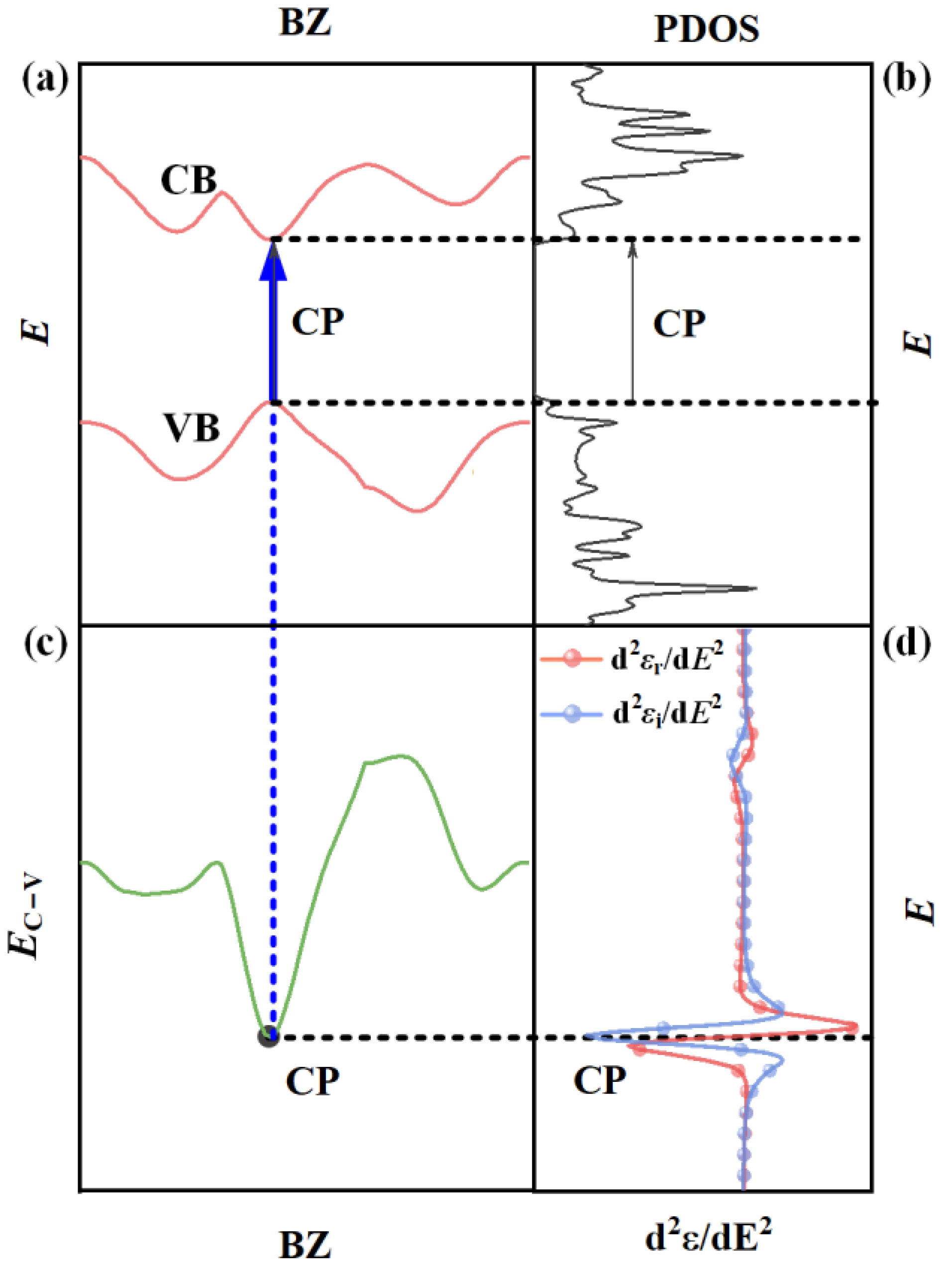
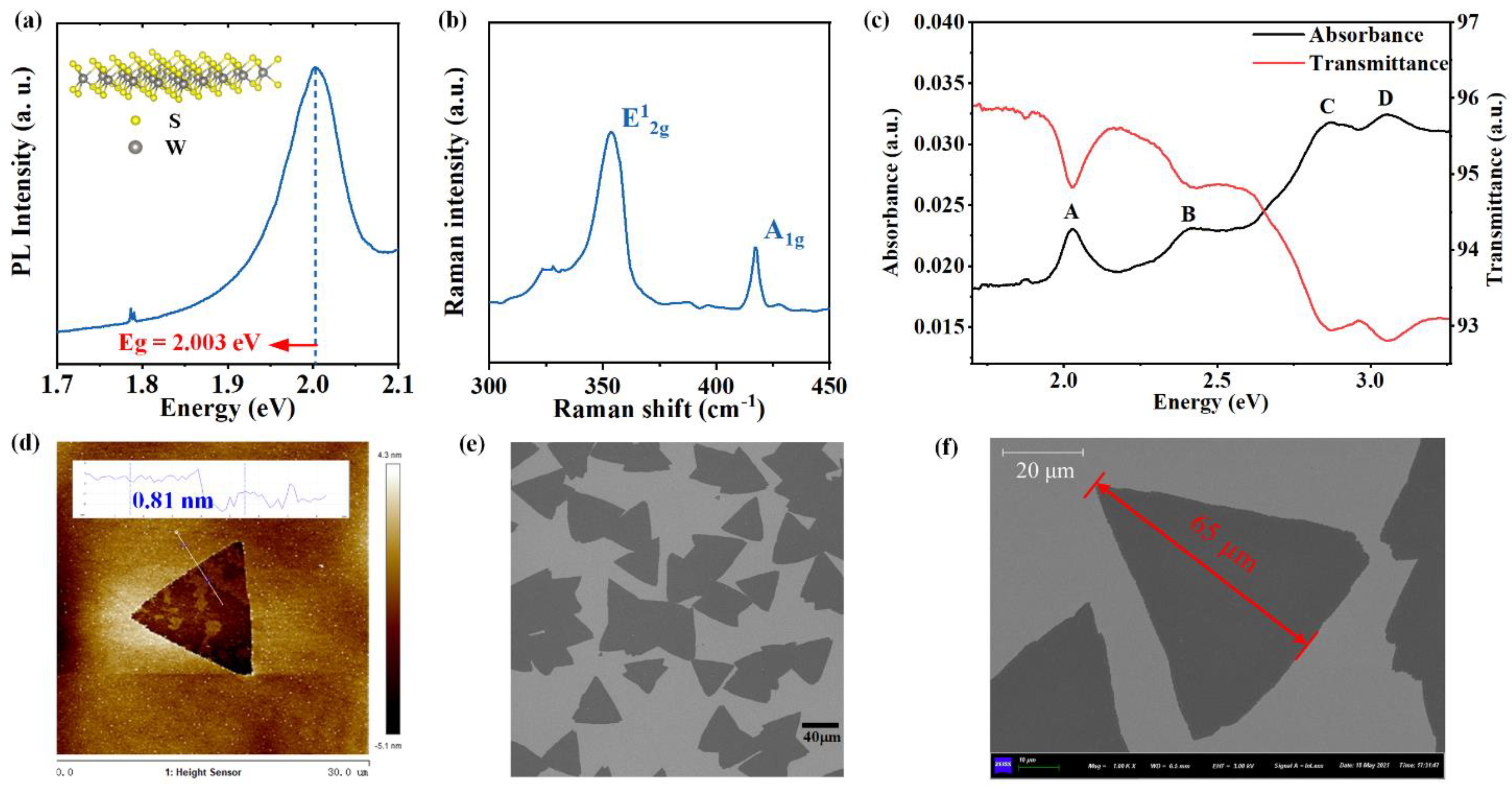
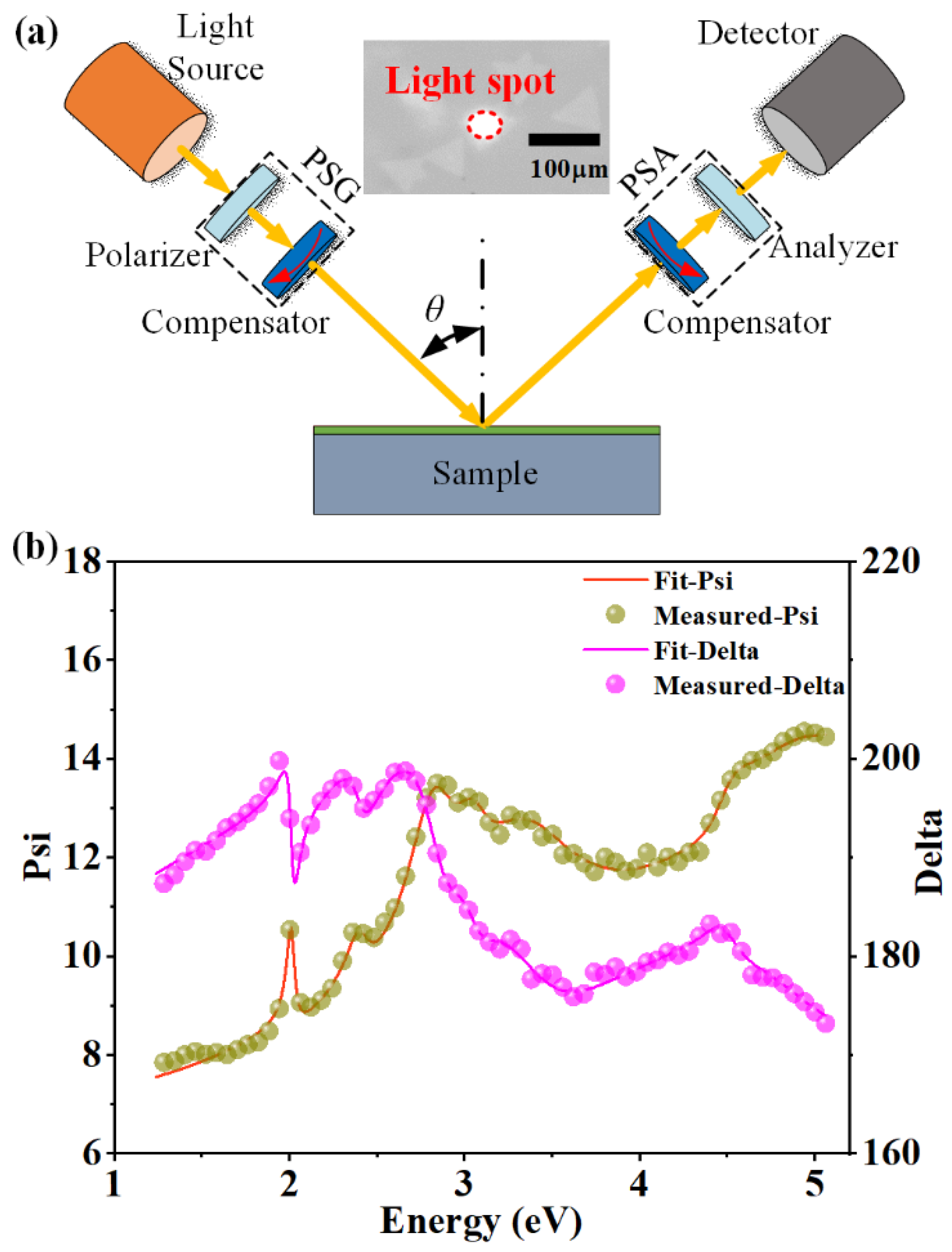
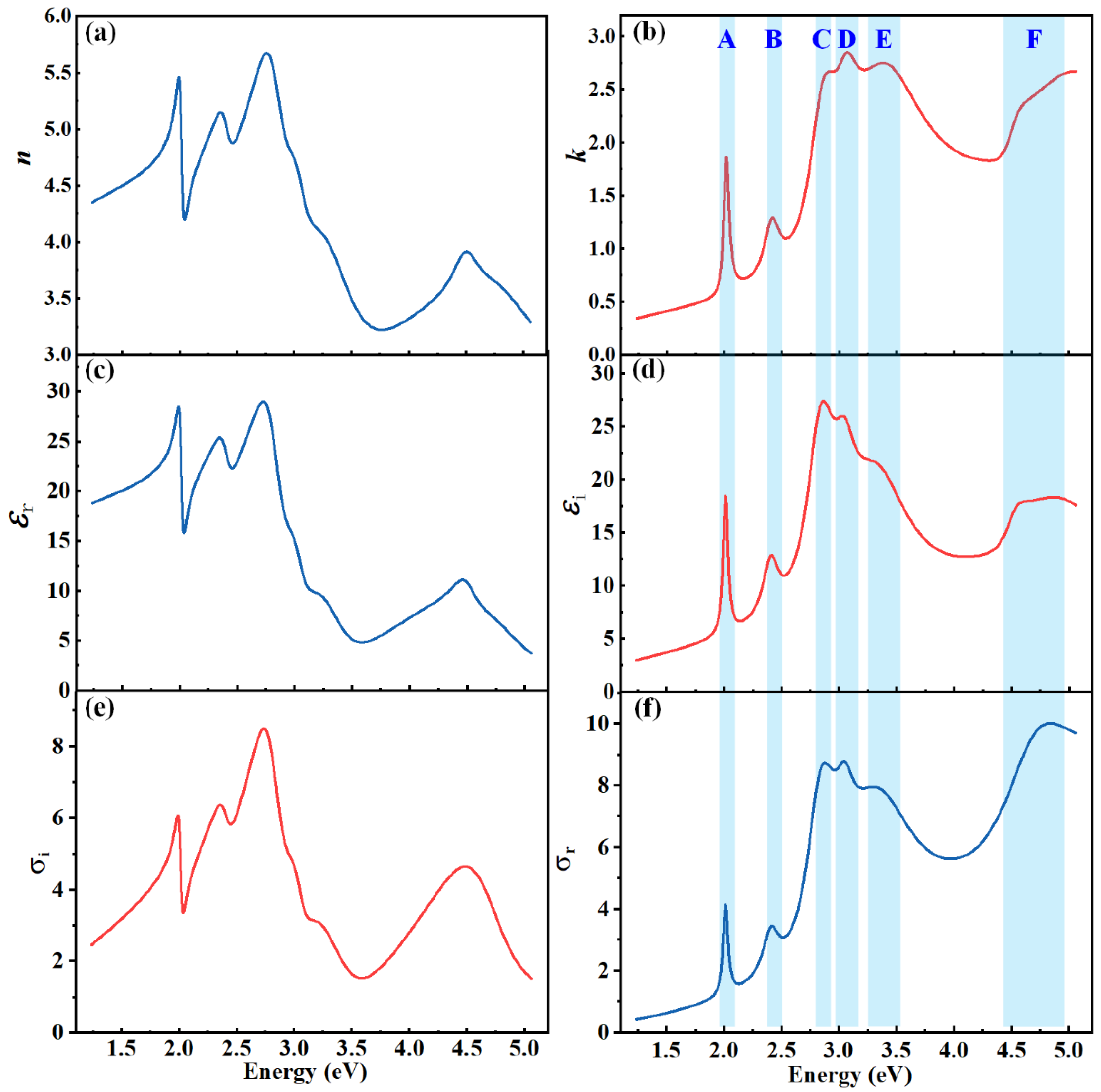
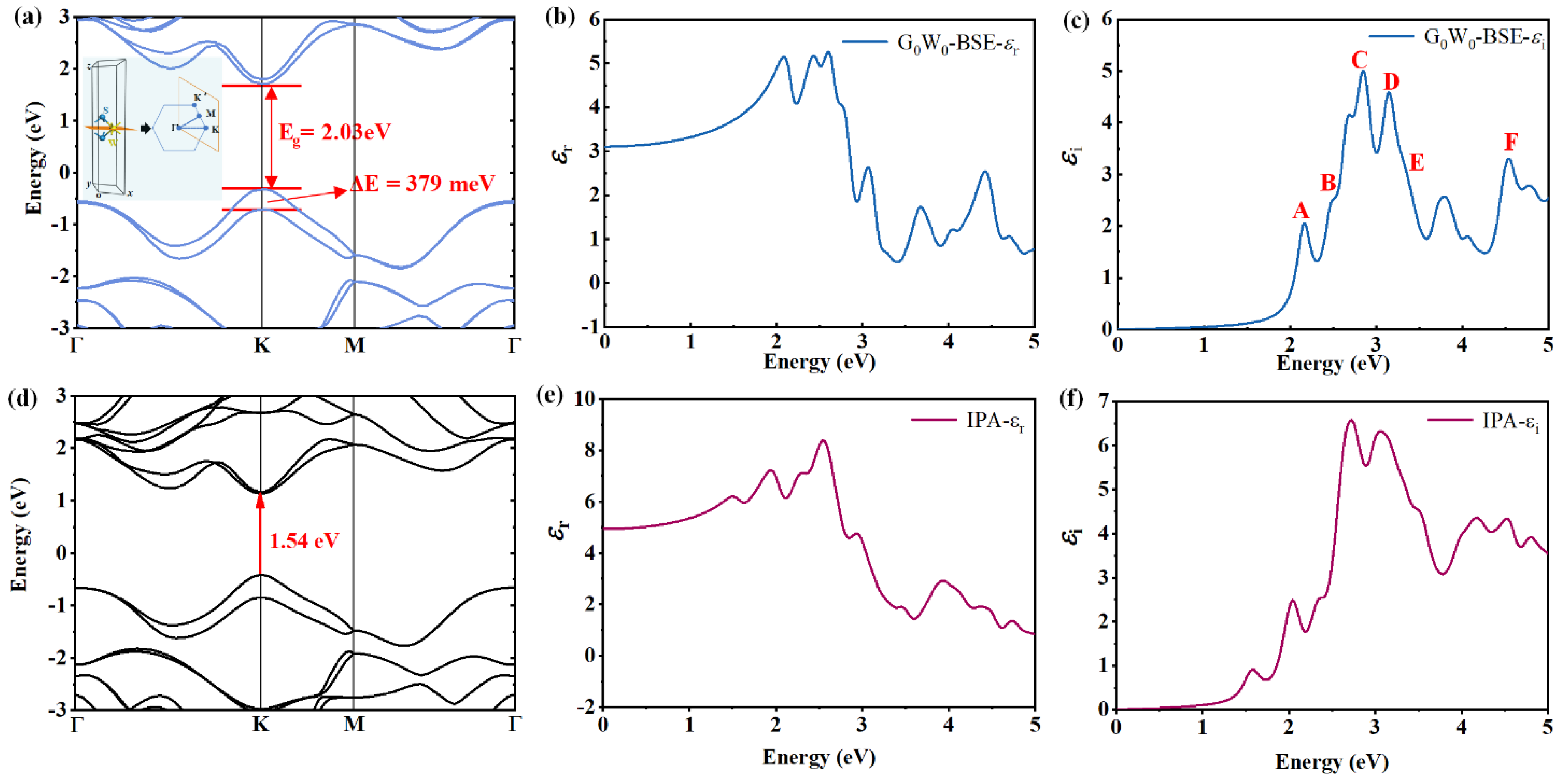
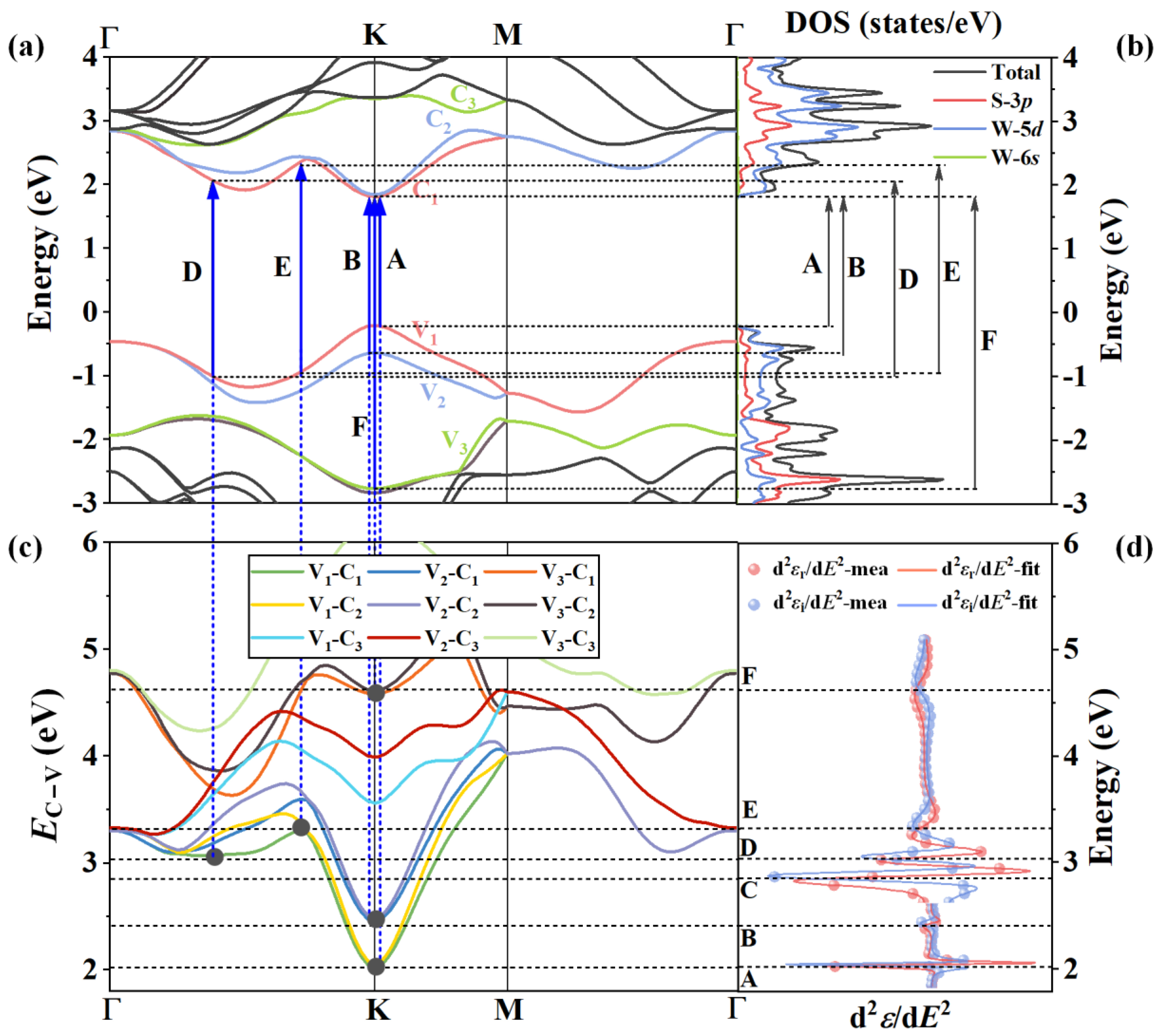
| E0 (eV) | A | B | C | D | E | F |
|---|---|---|---|---|---|---|
| SE | 2.019 | 2.410 | 2.844 | 3.033 | 3.318 | 4.438 |
| A and T | 2.031 | 2.428 | 2.879 | 3.064 | - | - |
| PL | 2.003 | - | - | - | - | - |
| First-principle | 2.160 | 2.495 | 2.846 | 3.147 | 3.352 | 4.535 |
| Parameter | A | B | C | D | E | F |
|---|---|---|---|---|---|---|
| A (no unit) | 0.376 | 0.423 | 1.329 | 1.202 | 2.971 | 0.885 |
| ϕ (°) | 135.087 | 109.951 | 91.137 | 110.086 | 128.801 | 114.215 |
| E0 (eV) | 2.019 | 2.410 | 2.844 | 3.033 | 3.318 | 4.438 |
| Γ (eV) | 0.042 | 0.098 | 0.126 | 0.161 | 0.330 | 0.265 |
Disclaimer/Publisher’s Note: The statements, opinions and data contained in all publications are solely those of the individual author(s) and contributor(s) and not of MDPI and/or the editor(s). MDPI and/or the editor(s) disclaim responsibility for any injury to people or property resulting from any ideas, methods, instructions or products referred to in the content. |
© 2023 by the authors. Licensee MDPI, Basel, Switzerland. This article is an open access article distributed under the terms and conditions of the Creative Commons Attribution (CC BY) license (https://creativecommons.org/licenses/by/4.0/).
Share and Cite
Gu, H.; Guo, Z.; Huang, L.; Fang, M.; Liu, S. Investigations of Optical Functions and Optical Transitions of 2D Semiconductors by Spectroscopic Ellipsometry and DFT. Nanomaterials 2023, 13, 196. https://doi.org/10.3390/nano13010196
Gu H, Guo Z, Huang L, Fang M, Liu S. Investigations of Optical Functions and Optical Transitions of 2D Semiconductors by Spectroscopic Ellipsometry and DFT. Nanomaterials. 2023; 13(1):196. https://doi.org/10.3390/nano13010196
Chicago/Turabian StyleGu, Honggang, Zhengfeng Guo, Liusheng Huang, Mingsheng Fang, and Shiyuan Liu. 2023. "Investigations of Optical Functions and Optical Transitions of 2D Semiconductors by Spectroscopic Ellipsometry and DFT" Nanomaterials 13, no. 1: 196. https://doi.org/10.3390/nano13010196
APA StyleGu, H., Guo, Z., Huang, L., Fang, M., & Liu, S. (2023). Investigations of Optical Functions and Optical Transitions of 2D Semiconductors by Spectroscopic Ellipsometry and DFT. Nanomaterials, 13(1), 196. https://doi.org/10.3390/nano13010196





